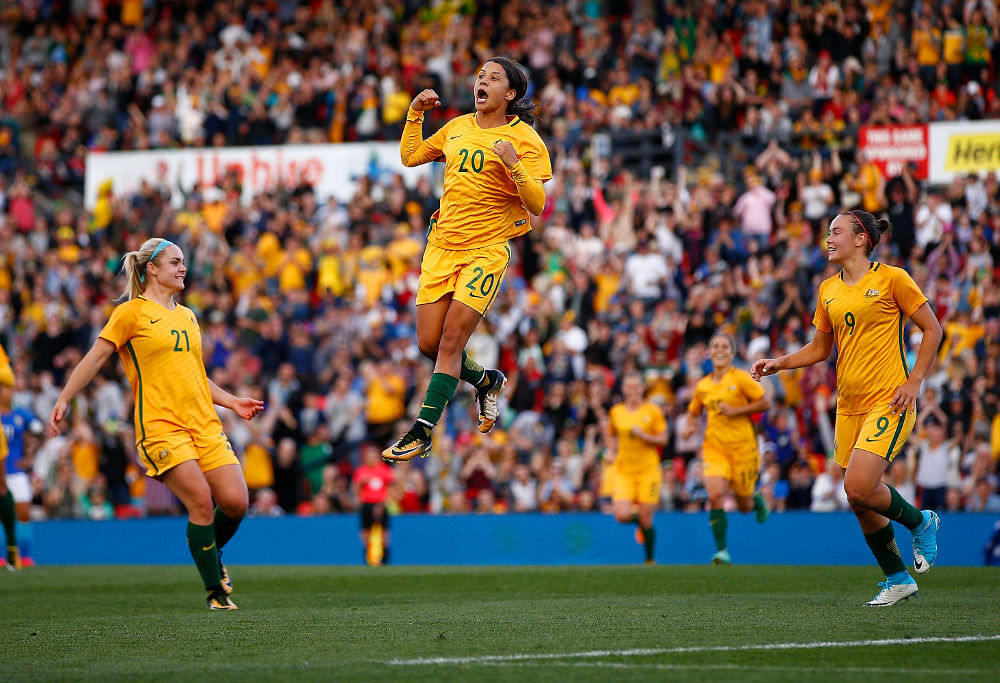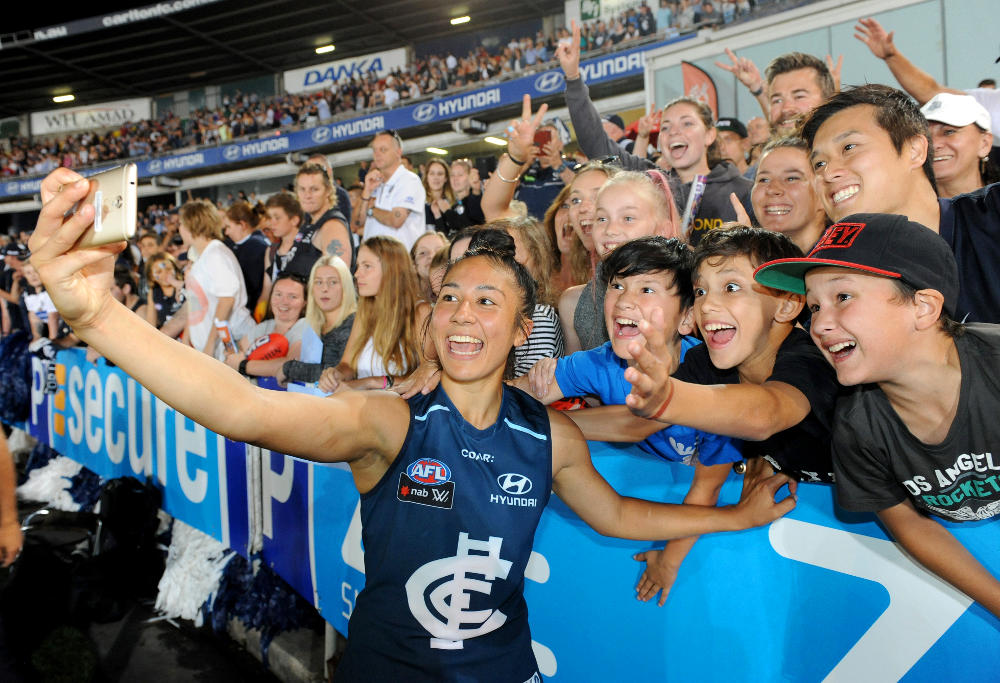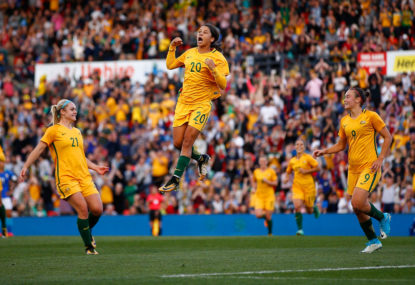When the history of women’s sport in Australia is being written a decade or more from now, 2017 will be remembered as a pivotal year.
Exactly how 2017 fits into the grand story of things is hard to say while we’re still living in it, but it wouldn’t be too far off the truth if it came to be known as the year women’s sport became mainstream, or, to be a little less articulate, the year it went big.
In the early part of the year there was one obvious reason for this – the launch of the inaugural AFLW season put women’s sport in the spotlight in Australia in a way it hadn’t been before.
Love or hate the AFL, you can’t disagree that they do an excellent job of promoting their game, and when they threw the weight of that remarkable promotional machine behind the AFLW, it was a big success, even more than they had hoped for.
The level of interest that sprung up around the season opener saw it moved to the biggest ground available, and even then thousands of people were locked out of the game.
AFL CEO Gillon McLachlan publicly apologised outside the gates to those fans who physically just could not be fit inside in one of the iconic moments of 2017 – while meanwhile, inside the ground, Darcy Vescio kicked four goals in another.

(AAP Image/Joe Castro)
AFLW proved to be a significant success and the fact the league has already made plans to expand to fourteen teams – up from eight in 2017 – in the next three years is an indicator of just how much support there has been.
The next big moment for women’s sport in 2017 came on the other side of the globe when the Matildas claimed their first ever win over the USA, 1-0, and then thrashed Brazil 6-1 to win the Tournament of Nations.
Victory in that tournament was probably the most significant Matildas achievement this year, and could be considered relatively small compared to an Olympic campaign last year or the World Cup looming on the horizon in 2019.
However, it’s indicative of the increased popularity and support for women’s sport across all codes in the country this year that the side’s friendlies in Australia this year drew big crowds and big support, even with nothing more than pride on the line.
A sold-out home crowd at Pepper Stadium in Penrith – the first time the Matildas have ever played in front of one – was one of the most memorable days of the year, and a watershed moment in the history of women’s sport in Australia.

(Photo by Zak Kaczmarek/Getty Images)
The Matildas are the most exciting thing in Australian women’s sport (and it’s a fierce competition for the title) – if you’d like to see Australia win a football World Cup someday, they’re the only team worth following.
Sam Kerr, in particular, will be remembered as one of the iconic sporting characters of 2017, and deserves to be spoken of in the same breath as Dustin Martin and Cameron Smith as one of the names and faces that defined the year in Australian sport.
Women’s sport continued to go from strength to strength as 2017 went on. In November, Australia’s women’s cricket and rugby league teams reasserted their dominance over the rest of the world with victory in the Women’s Ashes and in the Women’s Rugby League World Cup.
But perhaps the most important moments of the year in terms of building for the future have come just recently with both the NRL and Rugby Australia announcing domestic women’s competitions to be launched in 2018.
These organisations can’t have missed seeing how well the AFLW did this year and if there’s just a smidgen of codewars feeling motivating them to pick up the pace then I’d say that’s a good thing – a little healthy competition is good for us all.
But I wouldn’t ask you to just take my word for 2017 being a big year for women’s sport in Australia. The raw data shows it as well.
Twitter recently released a variety of data about 2017 and as you can see above, the AFLW has cracked into the top five most tweeted about sports in Australia for the year – a remarkable result in particular when you consider it has a relatively short season.
Twitter data shows that support for women’s sport is up across the board. The number of people following the Southern Stars on Twitter doubled this year, while the Jillaroos went up by 55 per cent and the Matildas by 15 per cent to a total of more than 53,000 followers.
Sam Kerr’s follower numbers on Twitter more than doubled in 2017 while Daria Gavrilova’s went up by 60 per cent and Erin Phillips’ increased by 52 per cent.
If that all doesn’t feel like a big enough deal, just have a think for a few moments about how much the A-League or Rugby Australia would be willing to give up to be able to look at 2017 as a year of comparable growth.
I was lucky enough to speak to both Alanna Kennedy of the Matildas and Alison Smirnoff, founder of Change Her Game while writing this article, and both agreed that 2017 has seen a significant growth in support for women’s sport.
How has it happpened, though? That’s a question that could take a while to answer, but it has to be recognised that passion lies at the centre of every advancement women’s sport has made – the passion that women have for the game and the commitment they’ve shown to it, often with little to no prospect of financial reward on the scale that exists in men’s sport.
Not only does that passion lead the people who have it to do big things, but it inspires others.

(AAP Image/Joe Castro)
Smirnoff says: “I decided to create Change Her Game partly after my experience working in professional men’s sport and also through watching women’s sport, specifically the women’s AFL exhibition match back in 2014. I was struck by the level of commitment and professionalism of the athletes despite the lack of financial reward.”
Meanwhile, Alanna Kennedy credits the Matildas’ growing popularity to the hard work that has been put in by everyone involved in recent years.
“We’ve got a good belief in our squad, players are playing out of their skins, Sam Kerr’s amazing, and when people come out and watch us it’s a good spectacle. We play good football, it’s attractive, it’s a credit to everyone involved and the hard work they’ve done over the last couple of years.”
Of course, it would be false to pretend that women having passion for sport is only a recent development – that’s been around a good while throughout history, and so there must be other factors at play also in why women’s sport has increasingly gained national attention.
In particular, I suspect the rise of social media and the power it puts in the hands of audiences to dictate to the kind of content they want to see while also providing independent content creators with an easy means to promote what they produce has been crucial in connecting fans to women’s sport.
“Social media plays an important role in women’s sport,” Smirnoff said. “While we’re still in this climate of intermittent coverage of women’s sport, social media is vital in terms of athletes being able to create their own media and engage directly with fans.”
Kennedy, of course, gave a unique perspective on what it’s like to use social media as an athlete. While it’s no surprise that there are a few pitfalls, it’s clear that on the whole it is a positive, uplifting experience.
“Social media’s probably been one of the biggest spaces I’ve seen an increase in the last twelve months… it’s great (to have that support). A lot of the time it’s young girls writing to you letting you know you’re an inspiration to them.”
The rise of women’s sport, really, is too great and complex a thing to give a simple explanation for. Every little good thing that happens sews the seeds of greater things to follow.
So what’s next? It’s pretty exciting to think that in 2018, all five of Australia’s biggest sports will have a domestic women’s competition of some variety, with Super W and women’s NRL joining the AFLW, WBBL and W-League – and of course Super Netball and women’s tennis are already well established.
If 2017 was a year where Australian women’s sport went big, 2018 will be the year it goes bigger.
































































































